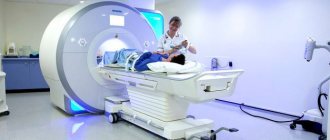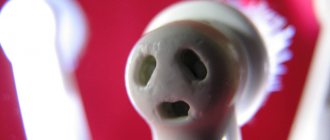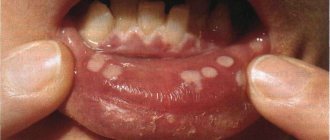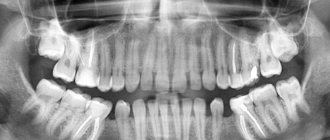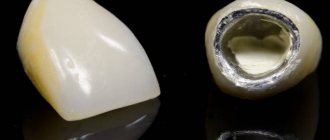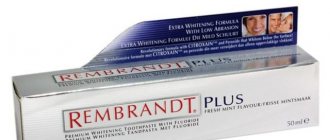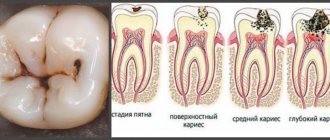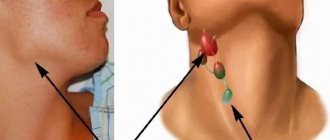An MRI machine, by generating a strong magnetic field around a person, is capable of examining many disorders and pathologies of organs and tissues, but it can have a negative effect on the body of patients who have metal foreign bodies. One of the contraindications for the MRI procedure is the presence of implants made of various metals and alloys. Implants are considered to be pins in bone tissue, joints, permanent structures, pacemakers, and dentures. Why do doctors recommend choosing a different examination method in the presence of metal implants? Is their presence an absolute contraindication for the procedure? If there are metal objects in the body, in particular titanium, is it possible to undergo an MRI or not?
MRI and metal plates
Depending on the relationship of any metal to the influence of a magnetic field, they are divided into diagmagnets (in the field they are subject to weak repulsion), paramagnetic (weakly attracted by the magnetic field) and ferromagnetic (strongly susceptible to the influence of the field).
In exceptional situations, the doctor may prescribe an MRI if the patient has metal plates. If there is metal in the body, the examination can only be carried out if its immediate location is outside the range of the magnetic field, or the diagnosis will be performed using low-field equipment. However, in the vast majority of cases, metal prostheses are a contraindication to the procedure.
In the presence of titanium plates in the leg and other parts of the body, diagnostics are carried out without restrictions, since titanium is paramagnetic and is not characterized by strong attraction in a magnetic field. MRI with a titanium prosthesis is as informative and harmless as without it.
How it works
Magnetic resonance and electromagnetic response measurements provide a clear three-dimensional image of the organ. This is a completely safe and painless test, however, due to the use of magnetic fields, it has its limitations. They relate to various metal devices and structures that may be in the human body and interfere with the procedure.
We invite you to familiarize yourself with Installation of implants on the upper jaw
Referred patients often ask if an MRI can be done with a post in the tooth. In short, yes, it is possible, but you need to remember some of the nuances of the examination.
MRI after stenting
After stenting, an MR examination is not only allowed, but also prescribed. Therefore, the answer to the question of whether it is possible to do an MRI after stenting is positive. But the specialist conducting magnetic resonance imaging must know exactly what material the stents are made of.
You can absolutely safely carry out examinations with bioabsorbable stents, since they consist of a biopolymer - after a given time they are absorbed, but the lumen of the vessel is preserved.
In other cases, stents are made of inert metal alloys: stainless steel, cobalt alloys, etc. Note that the patient is required to strictly follow the instructions for the stent, i.e. if it states that MRI should not be done in the first few weeks after stenting, then this applies not only to the area where the stent is installed, but to the entire body. Even if it is not directly located in the apparatus tunnel, the magnetic field works equally strongly in the room where the tomograph is installed.
Sometimes immediate diagnosis is necessary when the presence of a stent is not known before MRI is performed because the patient does not have time to report them. Practice has confirmed that the materials currently used for the manufacture of stents are not ferromagnetic and do not respond to external field influences, and, therefore, are MRI-compatible.
Who is prohibited from performing MRI?
It is prohibited to examine patients with magnetic resonance if:
- there are metal objects in the body (implanted hearing aids, prostheses, plates, pins, staples, clips, knitting needles, rods);
- there are post-traumatic foreign “non-medical” objects in the body (bullets, fragments, metal shavings);
- an implanted pacemaker has been installed (except for MRI-compatible ones);
- there are non-ferromagnetic prosthetic heart valves installed less than 6 months ago;
- had vascular stenting surgery less than 1 month ago;
- a non-monoblock artificial lens was implanted (has wire legs).
Why can't MRI be done on patients with implanted metal objects? It should be understood that a magnetic field can cause displacement of ferromagnetic materials located in soft tissues, for example, prosthetic heart valves, clips on blood vessels, or metal fragments in the patient’s body. Metal products installed in bone formations (vertebrae, jaws, long bones) do not move under the influence of the tomograph magnet, since they are rigidly fixed in solid structures.
If you place a person with metal objects in his body under a tomograph coil, the magnetic field it creates can heat them up. It is difficult to predict how the product will behave inside the patient’s body. To avoid dangerous consequences after the procedure, patients with metal objects in the body should avoid MRI examinations.
MRI is not performed on patients who require constant connection to life support devices (artificial ventilation, round-the-clock monitoring, hemodialysis).
Is it possible to do an MRI with iron crowns?
If you have old-style crowns made of iron, you cannot screen the brain and heart. The metal heats up significantly, which causes severe pain in the patient, deformation of the metal structure - the integrity of the implants may be compromised or they may fly off the teeth.
With crowns and dentures with metal-ceramics, screening of the brain and heart area is allowed, but there is a high probability of an unreliable result due to a distortion of the response to magnetic field signals.
Regardless of the type of alloys of crowns and prostheses, it is allowed to conduct MRI of the lumbar spine, abdominal organs and retroperitoneal space, pelvic region and extremities in closed-type devices.
When installing pins, high-strength titanium implants are often used. Their presence does not affect the reliability of the examination results; moreover, the size of the pins is so small that the magnetic field does not have any significant effect on them.
Metal crowns made of polymer alloys also do not distort magnetic field signals, however, you should check with your dentist about the possibility of conducting an MRI. Some structures heat up, so the procedure will cause significant discomfort to the patient.
If a patient has dental bridges installed, then they probably contain separate parts - pins, plates, screws of various sizes. For their manufacture, diamagnetic, ferromagnetic and paramagnetic materials are used - cobalt, iron alloy and nickel, which react differently to magnetic field signals. Therefore, you should check with your dentist what materials were used to make the prosthesis, and notify the tomography specialist - he will decide on the possibility of conducting an MRI.
Is it possible to put a pin in an implant?
No, and there is no point in such an operation either. Both the post and the implant support the crown but are not interchangeable components.
In addition, the pin can support a filling if most of the tooth is preserved and the filling also remains in place. During implantation, filling is not performed in principle - an artificial crown does not need a filling, and if the crown is damaged, it is easier to replace it entirely.
If you are in doubt what type of dental care you need, and what exactly needs to be installed in your case, contact our specialists by calling 597-05-05 or using the online application form.
Is it possible to do an MRI with braces?
Modern brace systems are made of expensive and durable alloys that do not deform under the influence of magnetic-nuclear radiation and cannot move or injure the patient’s oral mucosa.
Small structures do not distort tomograph signals and do not heat up; their response to a magnetic field is very weak.
You cannot do an MRI if a fairly voluminous structure - more than 20 cm - is secured with ferromagnetic retainers. In this case, the bracket may become hot.
Is it necessary to do an MRI if a bracket is swallowed to accurately determine its position in the intestine? It is impossible to swallow a large brace, but a small one will come out naturally. To speed up this process, you need to eat more viscous porridge and drink fluids.
Braces do not affect the patient's condition during MRI, but they can result in insufficiently reliable results when scanning the brain, heart area, thoracic or cervical spine.
In cases where it is urgently necessary to screen the brain and cardiac system, and doctors do not see an alternative to MRI, you should contact orthodontists and remove dental implants. After tomography, they are reinstalled in the required volume.
Placing the pin
The pin is a kind of fastening screw that allows you to firmly fix the denture in the jaw. This technology is widely used and is quite durable and high quality.
Types of pins
Carrying out an MRI with a pin in a tooth requires perhaps the most careful approach in terms of preparation. These devices have an extremely wide range of variations in their shape, type of fastening and, most importantly, the material used. Some are made from non-metallic compounds. With such structures, you can freely do an MRI with a pin in the tooth.
Other designs are made from different metal alloys. They often contain titanium, gold, platinum, but medical steel is also often used. The latter is precisely a ferromagnet, which is why it can seriously affect both the research procedure itself and the patient’s health.
Before performing an MRI scan of the head area with a dental post installed, it is necessary to determine its composition.
It is advisable to provide a passport of the implant, which will accurately indicate all its characteristics. Otherwise, it is extremely difficult to reliably judge whether a particular pin is ferromagnetic.
In such situations, MRI should be abandoned to avoid serious consequences.
Is it possible to do MRI with endoprostheses and other implants?
What to do if the patient has various types of implants right in his body? First of all, this must be reported to the specialist conducting the examination, since many metals are ferromagnetic and can shift in the body under the influence of a magnetic field.
For an MRI with a steel wire in the body, everything is not so simple. Iron causes the magnetic field to deviate from a given direction, which leads to distortion of the resulting images and the appearance of artifacts (defects) on them. In addition, the needle can heat up, creating unpleasant sensations for the patient.
Also, the answer to the question whether it is possible to do an MRI with an endoprosthesis depends on what material it is made of. If it is titanium, then there are no restrictions. If it is made of ferromagnetic materials, then this is a contraindication for research. You can find out exactly what metal the implant is made of in the design passport, which is issued to the patient after prosthetics.
Dental implants
The implant is designed to replace the missing tooth root, and therefore its implantation is a much more serious operation. This component is implanted directly into the bone tissue, and if the pin is an auxiliary structure, then the implant is the main support for the future crown.
An implant is placed only when it is not possible to save the tooth root. However, even with this, implantation has very strictly defined indications - and a large number of contraindications, since the operation uses a large amount of the body’s resources and the patient’s finances.
Advantages of pins
Installing a pin or pin tab has its undeniable advantages:
- Installation of the rod does not require trauma to the bone;
- It is possible to install a prosthesis on a single damaged tooth;
- A damaged crown can be restored without tooth extraction;
- Possibility of restoring the anterior group of teeth with fiberglass materials;
- Treatment is relatively quick;
- Good strength of the rod, which is achieved by uniform distribution of carbon fiber pins in the root canal;
- The titanium pin does not interfere with MRI;
- You can avoid tooth extraction even if it is 50% destroyed.
